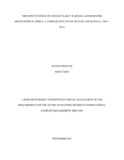| dc.description.abstract | The statement of problem of the study is that with increased conflict situation across the globe with weak mechanism to warn and respond despite such attempts. At the UN and AU level such moves to strengthen national capacity for conflict prevention and creating closer collaborative structures with both international and regional agencies, such mechanisms have not been optimal. Instead the threat to human security through armed conflicts, gross human rights abuses and genocide continue unabated. Research shows that the mechanisms were put in place to prevent and respond to conflicts are effective. Even where the warning is effective there is gap on response mechanism. Theobjective of the study is to analyse the effectiveness of the mechanisms in Africa with a focus on the two regional bodies IGAD and ECOWAS, during the ten-year period of 2005 to 2015. The study seeks to provide an overview of how the two regional bodies have responded to conflicts, compare and contrast their conflict prevention strategies worked, and finally identify academic as well as policy gaps in early warning and response mechanisms in Africa. The study adopted Boutros Ghali‘s ‗preventive diplomacy‘ as a theoretical framework for analysis and the it deals with conflict early warning systems and mechanisms at the sub-regional level and in a comparative nature. The prevention theory lays the basis for analytical approach to conduct to the research. The mechanismis today popular in the arena of conflict avoidance and management. However, devastating human atrocities continue to be experienced in Africa and elsewhere. An effective early warning system should therefore be established on the basis of support by the highest political authorities, and also has to rely will of grassroots organizations. The research used both primary and secondary sources of data. Due to budgetary constraints, however, one may challenge was access to data at regional bodiesMethodologically, mixed robust approaches tend to yield better results. The research findings have shown that CEWARN‘s relies on its network of monitors and responders. while, ECOWARN system takes advantage of its access to both government and civil society organizations. Further, ECOWARN is arguably a beneficiary of institutional link to the ECOWAS Mechanism for Conflict Prevention, Management, Resolution, Peace-keeping and Security. The study, therefore, recommends that early warning systems clearly identify their clients to be relevant. Additionally, these mechanisms must endeavor to bridge the policy gaps between strategies and clients. | en_US |



